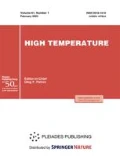Abstract
The objective of the present simulation is to analyze the performance of a twin thermoacoustic prime mover using CFD in terms of frequency and pressure amplitude. Pure fluid media such as helium, argon, nitrogen and their binary gas mixtures are studied at a constant operating pressure of 5 bar. The GAMBIT 2.3.16 pre-processor is used for creating the geometry of twin prime mover and the CFD package FLUENT 6.3 is used for simulating the device with different combinations of gas mixtures. The geometrical parameters and temperature gradients across the stack are kept constant throughout the simulation. It is found that the pressure amplitude of the thermoacoustic oscillations is higher for pure argon, whereas the frequency of the oscillations is higher for helium (495 Hz) rather than other gases and mixtures.
References
Rayleigh, J.W.S and Lindsay, R.B., The Theory of Sound, New York: Dover 1945, vol. 2.
Lycklama, J.A., Nijeholt, A., Tijani, M.E.H., and Spoelstra, S., J. Acoust. Soc. Am., 2005, vol. 118, no. 4, p. 2265.
Hantschk, C.C. and Vortmeyer, D., J. Sound Vib., 1999, vol. 277, no. 9, p. 758.
Zink, F., Vipperman, J., and Schaefer, L., Int. Commun. Heat Mass Transfer 2009, vol. 37, no. 30, p. 226.
Hariharan, N.M., Sivashanmugam, P., and Kasthurirengan, S., Int. J. Heat Mass Transfer 2013, vol. 64, no. 9, p. 1183.
Hariharan, N.M., Sivashanmugam, P., and Kasthurirengan, S., Int. J. Refrigeration 2013, vol. 36, no. 8, p. 2420.
Jabbar, P., Hariharan, N.M., Sivashanmugam, P., and Kasthurirengan, S., Eng. Comput. 2016, vol. 33, no. 3, p. 759.
Liu, J. and Garrett, S.L., J. Acoust. Soc. Am., 2005, vol. 119, no. 3, p. 1457.
Zink, F., Identification and Attenuation of Losses in Thermoacoustics: Issues Arising in the Miniaturization of Thermoacoustic Devices, Ph.D. (Mech. Eng.) Thesis, Pittsburg: Univ. Pittsburgh, 2009.
Hao, X.H., Ju, Y.L., Upendra, Behera, and Kasthurirengan, S., Cryogenics 2011, vol. 51, no. 9, p. 559.
Tijani, M.E.H., Zeegers, J.C.H., and de Waele, A.T.A.M., J. Acoust. Soc. Am., 2002, vol. 112, no. 1, p. 134.
Author information
Authors and Affiliations
Corresponding author
Additional information
The article is published in the original.
Rights and permissions
About this article
Cite this article
Hariharan, N.M., Sivashanmugam, P. CFD Simulation of Twin Thermoacoustic Prime Mover for Binary Gas Mixtures. High Temp 56, 309–311 (2018). https://doi.org/10.1134/S0018151X18020232
Received:
Published:
Issue Date:
DOI: https://doi.org/10.1134/S0018151X18020232

